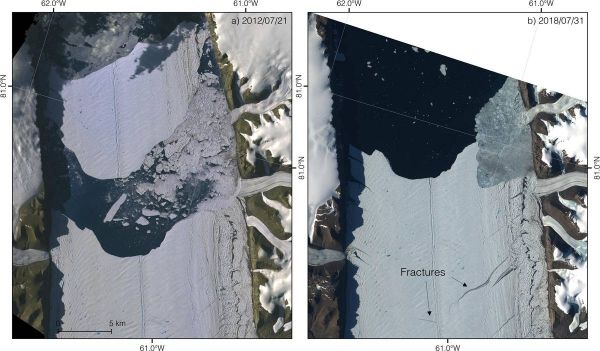Cracks in the floating ice tongue of Petermann Glacier in the far northwest reaches of Greenland indicate the pending loss of another large iceberg. As glaciologists from the Alfred Wegener Institute, Helmholtz Centre for Polar and Marine Research (AWI) report in a new study, the glacier’s flow rate has increased by an average of 10 percent since the calving event in 2012, during which time new cracks have also formed – a quite natural process. However, the experts’ model simulations also show that, if these ice masses truly break off, Petermann Glacier’s flow rate will likely accelerate further and transport more ice out to sea, with corresponding effects on the global sea level. The study was recently released in the “Journal of Geophysical Research: Earth Surface” and is freely available.
Located in the outermost northwest corner of Greenland, Petermann Glacier is one of the most prominent glaciers in the region: partly because its catchment encompasses four percent of the Greenland Ice Sheet, and partly because it is one of only three glaciers in Greenland with a floating ice tongue. That tongue currently extends roughly 70 kilometres into Petermann Fjord. Cracks 12 kilometres above the previous glacier edge indicate that, in the near future, another major iceberg could calve from Petermann Glacier.
Glaciologists at the Alfred Wegener Institute, Helmholtz Centre for Polar and Marine Research (AWI) in Bremerhaven came to this conclusion after analysing satellite imagery of the glacier from the past ten years. “The satellite data shows that Petermann Glacier had a flow speed of roughly 1135 metres per year in the winter of 2016. That equates to an acceleration of about 10 percent in comparison to the winter of 2011, and we asked ourselves what was responsible for the increased speed,” explains AWI glaciologist and co-author Niklas Neckel.
Continue reading at Alfred Wegener Institute
Image via Alfred Wegener Institute


